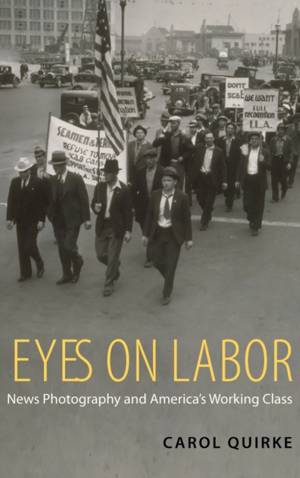
- Afhalen na 1 uur in een winkel met voorraad
- Gratis thuislevering in België vanaf € 30
- Ruim aanbod met 7 miljoen producten
- Afhalen na 1 uur in een winkel met voorraad
- Gratis thuislevering in België vanaf € 30
- Ruim aanbod met 7 miljoen producten
Zoeken
€ 164,45
+ 328 punten
Uitvoering
Omschrijving
In the twentieth century's first decades, U.S. workers waged an epic struggle to achieve security through unions; simultaneously Americans came to interpret current events through newspaper photographs. Eyes on Labor brings these two revolutions together, revealing how news photography brought workers into the nation's mainstream. Carol Quirke focuses on images ignored by scholars but seen by millions of Americans in the news of the day. Part visual analysis, part labor and cultural history, Quirke analyzes over one hundred photographs: stereographs of the Uprising of 1877, tabloid photos of the 1919 strike wave, photo-essays in the nationally popular LIFE Magazine, and even photos taken by a union camera club. Quirke anchors her interpretations in a lively historical narrative that takes readers from Washington D.C. hearings, to small towns in Indiana and Pennsylvania, to local union halls and to New York City boardrooms. Illuminating why unions, employers, and news
publishers vied to represent workers with the camera's eye, Eyes on Labor explores how Americans understood the complex and contradictory portrait of labor they produced.
publishers vied to represent workers with the camera's eye, Eyes on Labor explores how Americans understood the complex and contradictory portrait of labor they produced.
Specificaties
Betrokkenen
- Auteur(s):
- Uitgeverij:
Inhoud
- Aantal bladzijden:
- 376
- Taal:
- Engels
Eigenschappen
- Productcode (EAN):
- 9780199768226
- Verschijningsdatum:
- 13/08/2012
- Uitvoering:
- Hardcover
- Formaat:
- Genaaid
- Afmetingen:
- 239 mm x 163 mm
- Gewicht:
- 658 g

Alleen bij Standaard Boekhandel
+ 328 punten op je klantenkaart van Standaard Boekhandel
Beoordelingen
We publiceren alleen reviews die voldoen aan de voorwaarden voor reviews. Bekijk onze voorwaarden voor reviews.











